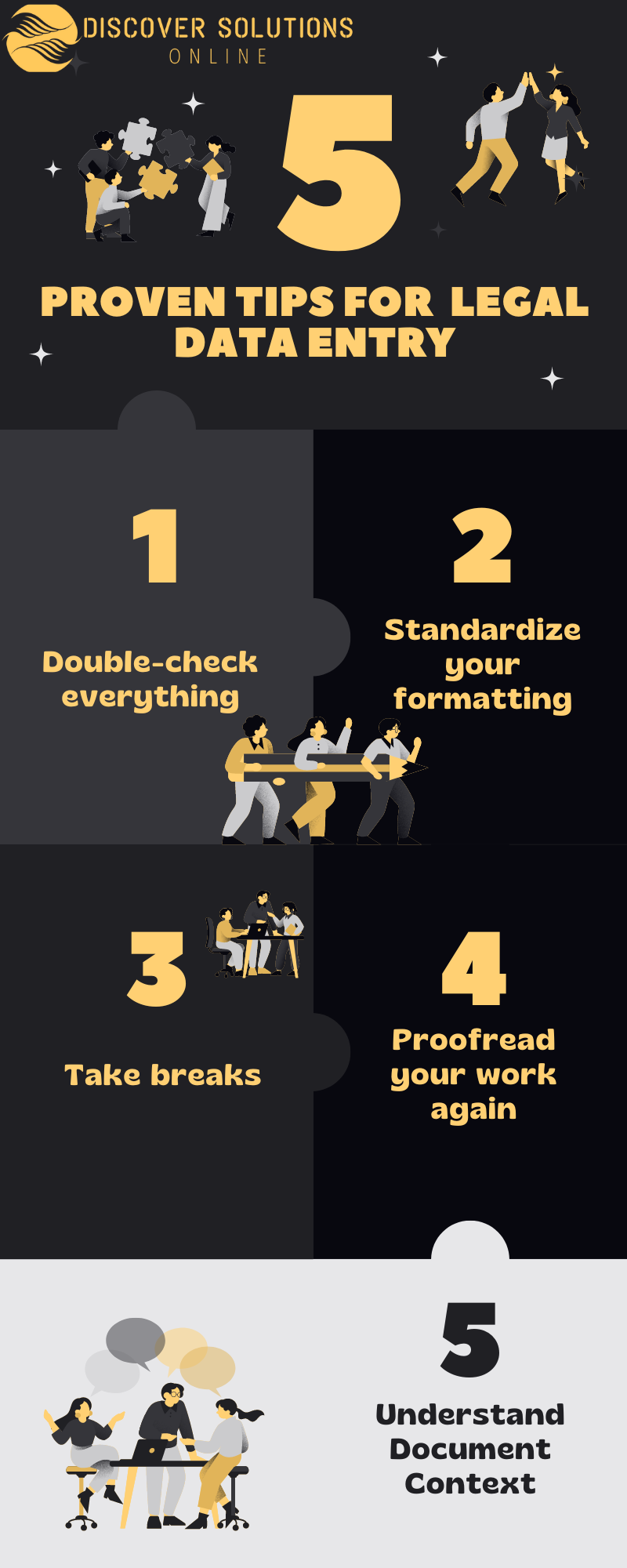Proofreading Like a Pro: Techniques for Catching Typos and Misspellings
Accurate Legal Data Entry hinges on meticulous attention to detail. The slightest typo or misspelling can lead to misinterpretations, errors, and even legal complications. Mastering the art of proofreading is, therefore, indispensable. In this section, we’ll delve into various techniques to help you proofread like a pro, empowering you to catch typos and misspellings with confidence.
Take a Break Before Proofreading
Before immersing yourself in the proofreading process, consider taking a short break. Stepping away from the document briefly allows you to reset your mind, providing a fresh perspective that can make it easier to spot errors overlooked during the initial data entry.
Change Your Reading Environment
A change of scenery can significantly impact your ability to focus on the details. If feasible, relocate to a different room or experiment with altering the font and background color of your document. Such adjustments can prevent your eyes from skimming over familiar text, facilitating the identification of typos and misspellings.
Read Aloud
An effective proofreading technique involves reading the text aloud. This engages both your visual and auditory senses. Pronouncing each word compels your brain to process the information differently, making it more likely that you’ll notice discrepancies and errors.
Proofread Backward
To disrupt the natural flow of your reading and focus solely on individual words, try proofreading backward. Start at the end of the document and work your way backward, sentence by sentence. This method helps identify isolated errors that might be overlooked in a traditional reading sequence.
Create a Proofreading Checklist
Developing a personalized proofreading checklist can ensure a systematic review of your work. Include items such as checking for common typos, verifying proper names, confirming dates and numbers, and ensuring consistent formatting. Following a checklist guarantees a thorough review and minimizes the risk of oversight.
Focus on One Type of Error at a Time
To avoid feeling overwhelmed, concentrate on specific types of errors during each proofreading session. For instance, dedicate one pass solely to spelling and another to grammar and punctuation. Breaking down the proofreading process into manageable tasks increases the likelihood of catching all potential errors.
Conclusion
Precision is non-negotiable in the meticulous world of Legal Data Entry. Mastering the art of proofreading is a skill that can elevate your accuracy and enhance the overall quality of your work. By implementing these techniques—taking breaks, changing your reading environment, reading aloud, utilizing spelling and grammar tools, proofreading backward, creating a checklist, and focusing on one type of error at a time—you’ll be well-equipped to catch typos and misspellings like a seasoned professional. Incorporate these practices into your routine, and witness your Legal Data Entry become a model of accuracy and reliability.

Double-Checking Data: Strategies for Verifying Information Accuracy
A single error can have far-reaching consequences, impacting legal proceedings, client relationships, and overall operational efficiency. To stay sharp and ensure error-free Legal Data Entry, it is crucial to implement robust double-checking strategies that verify the accuracy of information. In this section, we’ll explore various techniques and best practices to fortify your data entry processes.
Establish a Standard Operating Procedure (SOP)
The foundation of accurate data entry lies in a well-defined Standard Operating Procedure (SOP). Create a comprehensive guide that outlines the specific steps involved in data entry, including the format for dates, names, and other critical details. A standardized SOP acts as a reference point for data entry professionals, reducing the likelihood of errors resulting from inconsistent practices.
Implement Real-Time Error Feedback
Enable real-time error feedback during the data entry process. This involves using systems that provide instant alerts or prompts when inconsistencies or potential errors are detected. By addressing issues as they occur, data entry professionals can immediately correct errors, preventing them from propagating through the system and causing more significant problems down the line.
Double-Entry Verification
One classic but effective method for ensuring accuracy is the double-entry verification system. Under this approach, two different individuals independently enter the same data, and any discrepancies are flagged for review. While this method may be time-consuming, it significantly reduces the chances of errors slipping through undetected.
Random Sampling and Audits
Institute a practice of random sampling and periodic audits to assess the accuracy of entered data. By selecting a subset of entries for thorough review, you can identify patterns of errors, address root causes, and implement corrective measures. Audits provide insights into the overall accuracy of your data entry processes and serve as a proactive approach to error prevention.
Cross-Training and Skill Development
Invest in cross-training your data entry team members. By expanding their skill sets and knowledge base, you create a team that is not only proficient in data entry but also understands the nuances of legal terminology and documentation. This additional knowledge empowers team members to identify potential errors more effectively during the verification process.
Encourage a Culture of Accuracy
Foster a culture within your organization that values accuracy in data entry. Emphasize the importance of each team member’s role in maintaining the integrity of legal information. Recognize and reward accuracy, creating an incentive for employees to prioritize precision in their work.
Regular Training and Continuing Education
Stay ahead of industry changes and updates by providing regular training sessions and continuing education opportunities for your data entry team. Legal requirements and documentation standards evolve, and ensuring that your team is well-informed will contribute to accurate data entry practices.
Use Case-Specific Verification Protocols
Different types of legal documents may require unique verification protocols. Tailor your double-checking strategies to the specifics of the case or document at hand. This targeted approach allows for a more nuanced verification process that considers the intricacies of Legal Data Entry.
Conclusion
Implementing a robust double-checking strategy is the key to ensuring the accuracy of information. By establishing clear procedures, leveraging technology, and fostering a culture of accuracy, your organization can elevate its data entry practices, mitigating risks and contributing to the overall success of legal processes. Remember, the time and effort invested in double-checking data are a small price to pay compared to the potential consequences of inaccuracies in legal documentation. Stay vigilant, stay sharp, and make accuracy a non-negotiable standard in your Legal Data Entry processes.
Maintaining Focus: Avoiding Distractions and Burnout in Legal Data Entry
Errors can have serious consequences, making it crucial for professionals in this field to stay sharp and attentive. One of the major challenges faced by Legal Data Entry experts is the constant battle against distractions and the looming threat of burnout. In this section, we’ll explore various tips and tricks to help you maintain focus, avoid distractions, and prevent burnout in the high-stakes realm of Legal Data Entry.
Create a Dedicated Workspace
Setting up a designated and organized workspace is the first step in maintaining focus during Legal Data Entry. Ensure that your workspace is free from clutter and distractions. Invest in ergonomic furniture and equipment to create a comfortable environment that promotes concentration. By having a dedicated space, you signal to yourself and others that when you’re in this area, you’re focused on the task at hand.
Establish a Routine
Creating a daily routine can be a powerful tool in staying focused and minimizing distractions. Start your day at the same time, plan breaks strategically, and allocate specific time slots for different tasks. A routine not only helps in organizing your work but also trains your brain to switch into a focused mode at designated times, improving overall efficiency in Legal Data Entry.
Prioritize Tasks
Legal Data Entry often involves handling multiple tasks simultaneously. Prioritize your workload based on urgency and importance. Tackling high-priority tasks first ensures that critical information is entered accurately and on time. Break down larger tasks into smaller, more manageable steps to avoid feeling overwhelmed, and use task prioritization to guide your daily workflow.
Utilize Time Management Techniques
Adopting time management techniques can significantly enhance focus and productivity. The Pomodoro Technique, for example, involves working for short, focused intervals (usually 25 minutes) followed by a short break. This method helps combat burnout and keeps your mind fresh and engaged. Experiment with different time management strategies to find the one that works best for you.
Limit Multitasking
While multitasking may seem like a time-saving strategy, it often leads to errors and decreased productivity. Focus on one task at a time to ensure accuracy and completeness. This is particularly crucial in Legal Data Entry, where precision is paramount. By concentrating on a single task, you can reduce the likelihood of mistakes and improve overall data entry quality.
Take Regular Breaks
Avoiding burnout is essential for maintaining focus over the long term. Schedule regular breaks to recharge your mind and prevent mental fatigue. Use this time to step away from your workstation, stretch, and engage in activities that relax and rejuvenate you. Taking short breaks can improve overall concentration and contribute to error-free Legal Data Entry.
Practice Mindfulness
Incorporate mindfulness techniques into your daily routine to enhance focus and reduce stress. Mindfulness involves being fully present in the moment and can be achieved through practices such as meditation and deep breathing exercises. Integrating mindfulness into your workday can improve your ability to concentrate on complex Legal Data Entry tasks.
Establish Boundaries
In today’s interconnected world, setting boundaries is crucial to avoiding distractions. Clearly communicate your work hours to family, friends, and colleagues, and ask for their support in minimizing interruptions during these times. Establishing boundaries helps create a conducive work environment and allows you to stay focused on Legal Data Entry without unnecessary disruptions.
Conclusion
In the demanding field of Legal Data Entry, maintaining focus and avoiding distractions are essential for error-free performance. By implementing these tips and tricks, you can create a conducive work environment, establish effective routines, and mitigate the risk of burnout. Remember, staying sharp in Legal Data Entry is not just about speed but also about precision and accuracy. The efforts you invest in maintaining focus will undoubtedly pay off in the form of error-free and high-quality data entry.
How Discover Solutions Online Can Help
At Discover Solutions Online, we understand the critical nature of error-free Legal Data Entry. Our commitment to providing comprehensive solutions extends beyond just acknowledging the importance of accuracy; we actively support our clients in achieving it.
By choosing Discover Solutions Online, you gain access to a collaborative environment where accuracy is paramount. Our commitment to quality extends to fostering a culture of peer review within our team. Each project benefits from the insights and perspectives of multiple experts, significantly minimizing the risk of oversight and enhancing the overall precision of your legal data.
We encourage open communication, allowing you to provide specific guidelines, preferences, and unique considerations relevant to your Legal Data Entry requirements. This collaborative dialogue ensures that the final output aligns seamlessly with your expectations, further mitigating the chances of errors.





